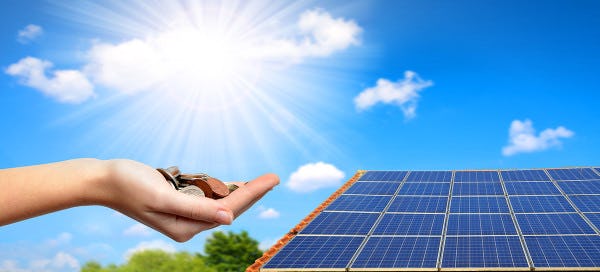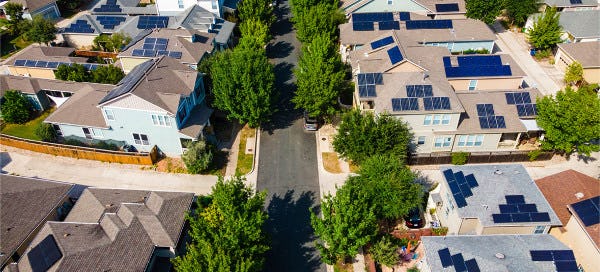Solar panels capture the Sun's energy to produce electricity that gets used in homes worldwide. Each solar cell soaks in the incoming light to generate an electrical current through the photovoltaic effect.
A series of plates and wires capture this electrical current and convert it into a usable electric current transmitted to your home and appliances. Keep reading to learn how solar panels generate renewable energy for your home.
What Is Solar Power?
Solar power, or solar energy, is emitted from the Sun and converted to renewable energy every day. It was first used as early as the 7th century BC when humans used sunlight to start fires. They did this by reflecting the Sun's rays with shiny objects.
Modern photovoltaic solar energy was invented in 1954 when Daryl Chapin, Calvin Fuller, and Gerald Pearson created silicon PV cells at Bell Labs. This silicon cell was the first solar cell to absorb and convert the Sun's energy into sustainable power that can power electrical equipment.
These fun facts are impressive, but that doesn't answer the question, "how does solar energy work?"
How Solar Power Works
To get the process started, you need solar panels. These convert solar power from the Sun into renewable electrical energy. The most common solar panel materials are monocrystalline silicon, polycrystalline silicon, and thin-film solar cells.
When the sunlight hits these semiconductive materials, it releases electrons from silicon atoms. Negatively charged electrons are then drawn to the cell's positively charged side.
The free-flowing electrons within the solar panel create this "photovoltaic effect." The circulating electrons generate an electric current, which creates energy via the wiring attached to the solar panels.
Solar panels can create more electricity when more sunlight reaches them. The units in your solar array receive the highest concentration of sunlight during peak sun hours, which means they can generate the most electricity during this time.
To learn more about solar energy visit our blogs:
Converting DC to AC
Solar panels produce electricity in direct current (DC) form, meaning the electricity flows in a single direction. However, most home appliances use alternating current (AC) electricity. This type of electricity flows in two directions.
You wouldn't want your appliances overloaded with power, so solar electricity provided by your panels must be changed from DC to AC to be used in your home. To make this switch, you need a power converter.
There are different types of converters, and the kind you need depends on the size and design of your solar energy system. Simple systems use a string inverter, a single box close to your circuit breaker in the primary location. Complex systems use a microinverter on each individual panel. Other types of inverters include power optimizers and hybrid inverters.
You can connect your solar energy system to the internet with a solar inverter. This approach gives you access to information about the performance of your system, which is perfect for comparing energy produced and energy consumption.
Distributing Electricity Via an Electric Panel
Your electrical panel is in charge of distributing power within your home. In the event of a malfunction or surge, the circuit breakers in the electrical panel can also shut off the flow of electricity to an electrical circuit, preventing damage to wires and appliances.
While solar panels generate power, they aren't usually connected to your appliances or other electronic items directly. In terms of how solar panels work, they provide electricity to the electrical panel, which divides that home solar power into individual circuits that run to all of the home's different rooms.
Electrical panels are a vital part of the consumption monitoring process. Some devices can be linked to either the main panel or each circuit, allowing you to see more specifics about your unique energy use and helping you optimize it over time.
Recording Production and Consumption
The equipment your utility provider uses to measure your electricity consumption is known as your electric meter. It provides the data that the utility uses to calculate how much to charge you each month.
Your energy company may have a technician check your meter in person once a month since older electric meters have analog dials that spin as current flows through them. That meter reading is merely a summary of your monthly electricity usage. Modern meters may be wireless, transmitting data directly to the utility company.
When you switch to renewable energy like solar, you use power generated by your solar panels rather than electricity from the grid, reducing the amount of electricity you must pay for. As a result, your electric meter records significantly less consumption, and you save money by not paying the utility provider for that electricity.
Most solar-powered homes have a smart meter installed, tracking your home's actual electricity consumption. Your local utility provider receives real-time usage data from smart meters for invoicing, customer service, and research purposes. By detecting exactly how much electricity you use, a smart meter eliminates the need for approximated bills.
Storing Excess Energy
To get the most out of going solar, you'll need to install solar battery storage. When you do, you can store excess solar energy in a solar battery if your solar panels create more solar energy than you can use. Instead of drawing electricity from the grid when the Sun goes down or when it's raining, you'll have electricity available in the battery.
Solar batteries can either store extra DC electricity generated by your solar panels or be charged using AC current that has already been converted by your inverter, depending on your setup.
Surplus Solar Energy Gets Exported to the Grid
Most homes generate more solar electricity than their overall electrical loads required. When this happens, the extra energy can be sent out into the electric grid through your utility meter. The utility meter can track how much electricity you export to the grid and how much electricity you import from it.
Factors Affecting Solar Energy Production
Homeowners need to consider three primary factors when it comes to producing their solar power. First is the amount of shade potentially cast upon the panels. Shaded panels will struggle to produce sufficient energy, unlike those in direct sunlight.
The second is the changing seasons. Solar energy production will vary along with the amount of sunlight available each day and month. A cloudy January day won't provide as much power as a bright August one. But luckily, in Texas, there is an abundance of sunlight year-round.
Finally, the tilt of your roof and the direction your home faces affect how well residential solar systems work. Ideally, solar panels should be installed at the same angle as the latitude where they will be used. In most situations, roof pitches ranging from 30 to 45 degrees work effectively.
Solar Energy at Night
Solar panels need direct access to the Sun to produce adequate power. However, this isn't possible at night. A grid-tied solar panel system — the most common type of solar energy system — uses power imported from your utility provider to service your electrical needs after dark.
If your state provides 1:1 net metering, which is now available in 38 out of 50 states, the surplus power your system generates throughout the day gets utilized to offset the expense of your nighttime electricity purchases.
Battery Backup Power
Homeowners living in areas prone to blackouts find their solution in battery storage as a backup power source. These batteries produce less noise than standard diesel generators and are cleaner to operate. Battery backup power further reduces your carbon footprint because these batteries don't need to get refueled.
Find Your Place with Rhythm Energy
You've already invested in renewable energy and have probably seen the difference in energy savings. Why not make one more decision to keep more money in your pocket? Partner with the right electricity provider, like Rhythm Energy, and you'll see your savings begin growing.
We believe in sustainable energy, like solar power. But we also believe in supporting our customers in every way we can. That's why we've established the Rooftop Solar Buyback Plan that pays our customers for their unused energy!
Your solar system produces enough energy to power your home every month with electricity to spare. You can send it to the grid to help your neighbors benefit from renewable energy, and in return, you'll see a buyback credit on your monthly statement.
It's easy to get started and begin stacking your savings. A representative is available at Rhythm Energy 24/7, so you can have your questions answered at your convenience. Call us today!




